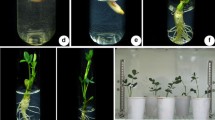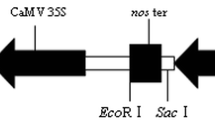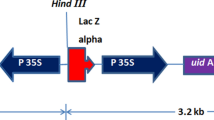Abstract
Ustilago scitaminea is the causal agent of sugar-cane smut disease. There is, however, no genetic transformation method for it. Here we report the development of an efficient mutagenesis method based on Agrobacterium tumefaciens-mediated transformation. To improve transformation efficiency, a range of conditions, including the codon-usage preference of the selection marker gene, promoters and the culture conditions for transformation were optimized. A strong promoter to drive marker gene expression, optimized codon usage of selection marker gene, controlled water content and pH of co-culture medium were critical factors affecting transformation efficiency. Our findings provide a useful tool for genetic analysis of this important plant pathogen.




Similar content being viewed by others
References
Abbott EP, Ianiri G, Castoria R, Idnurm A (2013) Overcoming recalcitrant transformation and gene manipulation in Pucciniomycotina yeasts. Appl Microbiol Biotechnol 97:283–295
Bakkeren G, Kronstad JW (1996) The pheromone cell signaling components of the Ustilago α mating-type loci determine intercompatibility between species. Genetics 143:1601–1613
Bundock P, den Dulk-Ras A, Beijersbergen A, Hooykaas PJ (1995) Trans-kingdom T-DNA transfer from Agrobacterium tumefaciens to Saccharomyces cerevisiae. EMBO J 14:3206–3214
de Groot M, Bundock P, Hooykaas P, Beijersbergen A (1998) Agrobacterium tumefaciens-mediated transformation of filamentous fungi. Nat Biotechnol 16:839–842
Ferreira S, Comstock J (1989) Smut. In: Ricaud C, Egan B, Gillaspie J, Hughes C (eds) Diseases of sugar-cane. Major diseases. Elsevier, Amsterdam, pp 211–229
Ji L, Jiang ZD, Liu Y, Koh CM, Zhang LH (2010) A simplified and efficient method for transformation and gene tagging of Ustilago maydis using frozen cells. Fungal Genet Biol 47:279–287
Lazo GR, Stein PA, Ludwig RA (1991) A DNA transformation-competent Arabidopsis genomic library in Agrobacterium. Biotechnology 9:963–967
Liu Y, Koh CM, Sun L, Hlaing MM, Du M, Peng N, Ji L (2013) Characterization of glyceraldehyde-3-phosphate dehydrogenase gene RtGPD1 and development of genetic transformation method by dominant selection in oleaginous yeast Rhodosporidium toruloides. Appl Microbiol Biotechnol 97:719–729
Michielse CB, Hooykaas PJ, van den Hondel CA, Ram AF (2005) Agrobacterium-mediated transformation as a tool for functional genomics in fungi. Curr Genet 48:1–17
Morita T, Ishibashi Y, Hirose N, Wada K, Takahashi M, Fukuoka T, Imura T, Sakai H, Abe M, Kitamoto D (2011) Production and characterization of a glycolipid biosurfactant, mannosylerythritol lipid B, from sugar-cane juice by Ustilago scitaminea NBRC 32730. Biosci Biotechnol Biochem 75:1371–1376
Mullins ED, Chen X, Romaine P, Raina R, Geiser DM, Kang S (2001) Agrobacterium-mediated transformation of Fusarium oxysporum: an efficient tool for insertional mutagenesis and gene transfer. Phytopathology 91:173–180
Shi L, Fang X, Li M, Mu D, Ren A, Tan Q, Zhao M (2012) Development of a simple and efficient transformation system for the basidiomycetous medicinal fungus Ganoderma lucidum. World J Microbiol Biotechnol 28:283–291
Soltani J, Heusden GP, Hooykaas PJ (2008) Agrobacterium-mediated transformation of non-plant organisms. In: Citovsky V, Tzfira T (eds) Agrobacterium: from biology to biotechnology. Springer, New York, pp 649–675
Sundar AR, Barnabas EL, Malathi P, Viswanathan R (2012) A mini-review on smut disease of sugarcane caused by Sporisorium scitamineum. In: Mworia J (ed) InTech, vol 5. InTech Europe, Winchester, pp 107–128
Weng LX, Deng HH, Xu JL, Li Q, Wang LH, Jiang ZD, Zhang HB, Li QW, Zhang LH (2006) Regeneration of sugar-cane elite breeding lines and engineering of stem borer resistance. Pest Manag Sci 62:178–187
Acknowledgments
This work was supported by the National Natural Science Foundation of China (Project No. 31271993) and the Temasek Trust and the Economic Development Board, Singapore. The authors express sincere gratitude to Prof. Lian-Hui Zhang, Institute of Molecular and Cell Biology, Singapore for his valuable suggestions and revision of the manuscript.
Author information
Authors and Affiliations
Corresponding author
Electronic supplementary material
Below is the link to the electronic supplementary material.
Rights and permissions
About this article
Cite this article
Sun, L., Yan, M., Ding, Z. et al. Improved dominant selection markers and co-culturing conditions for efficient Agrobacterium tumefaciens-mediated transformation of Ustilago scitaminea . Biotechnol Lett 36, 1309–1314 (2014). https://doi.org/10.1007/s10529-014-1486-5
Received:
Accepted:
Published:
Issue Date:
DOI: https://doi.org/10.1007/s10529-014-1486-5




